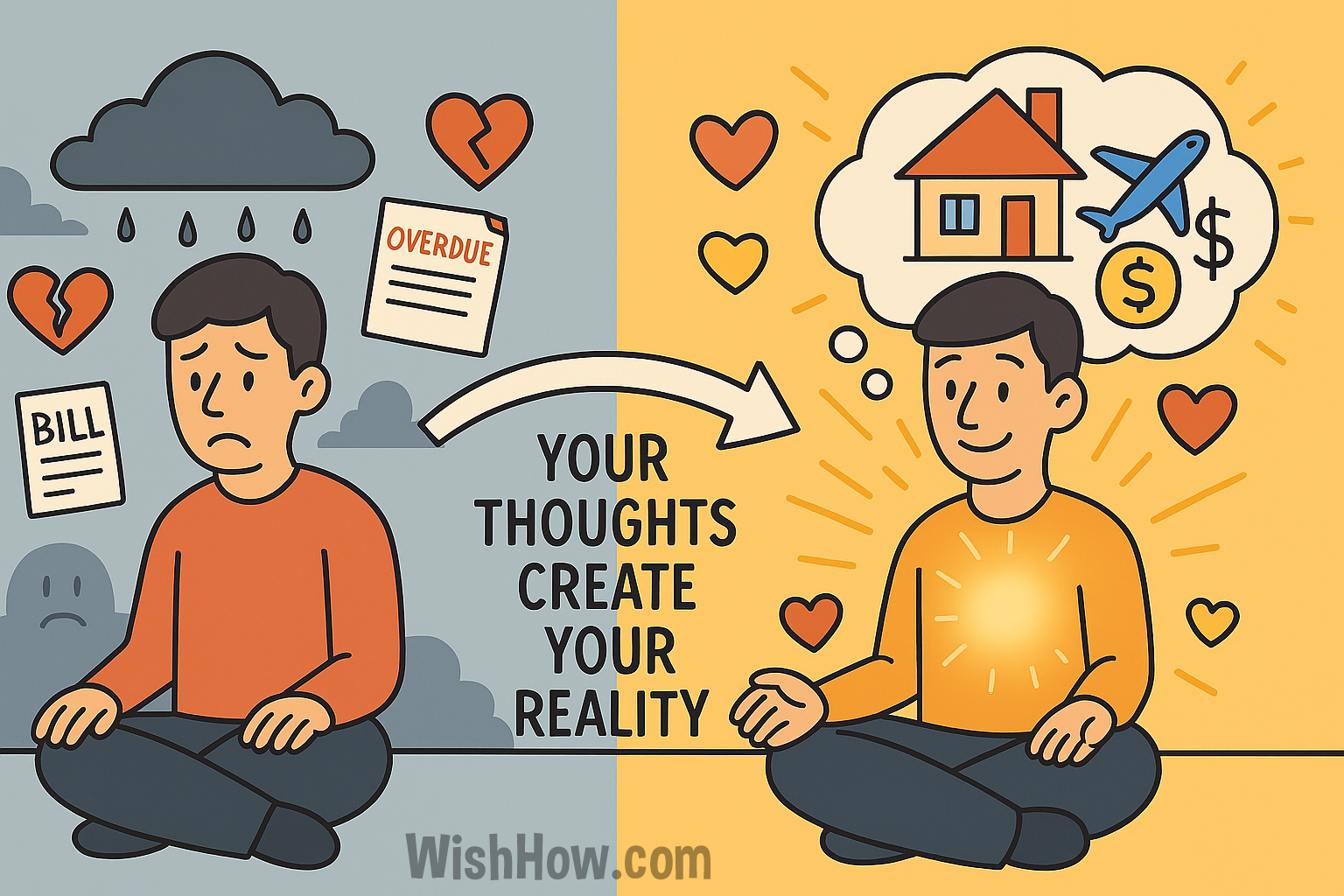In recent years, the concept of the law of attraction has gained massive popularity, driven by books, documentaries, and a growing movement of people seeking personal transformation. But what exactly is the law of attraction, and how does it impact the way we manifest our desires?
Whether you’re new to the concept or looking to deepen your understanding, this in-depth article will explore everything you need to know. We’ll break down the science and philosophy behind the law of attraction, how it relates to manifestation, techniques to apply it in daily life, and address common misconceptions. Plus, we’ll answer frequently asked questions and share references for further reading.
1. Introduction
If you’ve ever heard phrases like “thoughts become things” or “you attract what you are,” you’ve already encountered the essence of the law of attraction. This universal principle posits that your mindset, beliefs, and energy can shape your external reality. At its core, the law of attraction suggests that like attracts like: positive thoughts attract positive outcomes, while negativity breeds more negativity.
But how does this concept tie into manifestation—the act of bringing dreams, goals, or intentions into reality? Let’s dive deep and uncover the connections.
2. What Is the Law of Attraction?
The law of attraction is a metaphysical principle stating that the energy you emit through thoughts, emotions, and beliefs magnetically attracts similar energies and outcomes into your life.
In simple terms:
- Positive thinking and emotions → attract favorable outcomes.
- Negative thinking and emotions → attract undesirable outcomes.
According to the law of attraction, your internal world (thoughts, beliefs, energy) mirrors your external world (experiences, events, results).
This law operates on the belief that the universe is made of energy, and everything—including your thoughts—has a vibrational frequency. By aligning your thoughts and emotions with what you desire, you essentially “tune in” to a reality where your desire exists.

3. Origins and History
Although popularized in modern times, the law of attraction is not new. Its principles can be traced back to ancient spiritual traditions, philosophical writings, and even religious texts.
Early Influences:
- Hermetic Philosophy: In The Kybalion (1908), the concept “As above, so below; as within, so without” reflects the interconnectedness of thought and reality.
- Buddhism and Hinduism: Emphasize karma, energy, and the power of intention.
- Christian Scripture: Verses like Mark 11:24 (“Whatever you ask for in prayer, believe that you have received it, and it will be yours”) echo the law of attraction.
Modern Revival:
- New Thought Movement (19th Century): Figures like Phineas Quimby and Wallace D. Wattles wrote about mind power, abundance, and healing.
- Napoleon Hill’s Think and Grow Rich (1937): Emphasized the power of thought and belief in achieving wealth.
- Rhonda Byrne’s The Secret (2006): Catapulted the law of attraction into mainstream consciousness with its documentary and bestselling book.
4. The Science Behind It
Skeptics often question the validity of the law of attraction. While it may not be a “law” in the scientific sense, aspects of it align with cognitive science, quantum physics, and psychology.
1. Reticular Activating System (RAS)
This part of the brain filters information and prioritizes what you focus on. When you set intentions, your RAS becomes attuned to spotting opportunities aligned with your goals.
2. Neuroplasticity
Repeated thoughts shape neural pathways. By consciously thinking positively or visualizing success, you strengthen circuits that promote resilience and optimism.
3. Mirror Neurons and Emotional Contagion
Your emotional state affects others. Positive energy can attract like-minded individuals, creating a feedback loop of beneficial interactions.
4. Quantum Physics
Though controversial in this context, some proponents argue that quantum theory supports the idea that observation (consciousness) can affect outcomes. While mainstream physics does not endorse this interpretation, it fuels philosophical debate.
5. How the Law of Attraction Affects Manifestation
Manifestation is the process of turning thoughts or desires into tangible reality. The law of attraction serves as the underlying mechanism.
How to Connect (Mindfulness Essentials Book 8)
$1.99 (as of April 28, 2025 21:51 GMT -07:00 - More infoProduct prices and availability are accurate as of the date/time indicated and are subject to change. Any price and availability information displayed on [relevant Amazon Site(s), as applicable] at the time of purchase will apply to the purchase of this product.)Step-by-Step Process:
- Clarity of Desire: Know exactly what you want.
- Emotional Alignment: Feel as if it has already happened.
- Visualization: Use mental imagery to reinforce your belief.
- Positive Affirmations: Replace limiting beliefs with empowering ones.
- Inspired Action: Take real-world steps that align with your goals.
- Detachment and Trust: Let go of obsession and trust the process.
When applied correctly, the law of attraction becomes a bridge between desire and fulfillment.
6. Techniques to Use the Law of Attraction
If you’re ready to harness the power of the law of attraction, try these time-tested techniques:
1. Vision Boards
Create a collage of images representing your goals. Place it somewhere you’ll see daily to reinforce your focus and alignment.

2. Daily Affirmations
Speak or write positive statements about your desired reality in the present tense:
“I am worthy of success.”
“Money flows to me easily and abundantly.”
3. Gratitude Practice
Gratitude shifts your focus to abundance, elevating your vibrational frequency.

4. Scripting
Write a journal entry as if you’ve already achieved your goal. Example: “Today I signed the contract for my dream home. I feel so proud and grateful!”
5. Meditation and Visualization
Spend a few minutes daily visualizing your goals with intense emotional involvement. Feel the joy, gratitude, and excitement.

6. Letting Go
This is crucial. Obsession and fear lower your vibration. Trust that the universe is working in your favor.
7. Real-Life Examples
Many successful people credit the law of attraction for their achievements:
- Jim Carrey famously wrote himself a $10 million check for “acting services rendered” and dated it for 1995. He received that amount for Dumb and Dumber that year.
- Oprah Winfrey often speaks about the power of intention and belief in shaping her success.
- Will Smith, Conor McGregor, and Lady Gaga have publicly shared their belief in visualization and manifestation techniques.
8. Common Misconceptions
Despite its popularity, the law of attraction is often misunderstood. Let’s clear up some myths:
Myth 1: “Just Think Positive and Do Nothing”
Truth: Positive thinking is only part of the equation. Inspired action is necessary.
Myth 2: “It’s Magic or Pseudoscience”
Truth: While spiritual in nature, many principles are grounded in psychology and neuroscience.
Myth 3: “If Bad Things Happen, It’s Your Fault”
Truth: Life involves a mix of circumstances. The law of attraction empowers but doesn’t control every outcome.
Myth 4: “It Works Instantly”
Truth: Manifestation takes time, alignment, and patience.
9. FAQ
Q1: Is the law of attraction real?
The law of attraction is real as a philosophical and psychological principle. While not a scientific “law,” many find value in its application.
Journey to the Heart: Daily Meditations on the Path to Freeing Your Soul
$9.89 (as of April 28, 2025 21:51 GMT -07:00 - More infoProduct prices and availability are accurate as of the date/time indicated and are subject to change. Any price and availability information displayed on [relevant Amazon Site(s), as applicable] at the time of purchase will apply to the purchase of this product.)Q2: Can I manifest anything?
You can manifest things aligned with your beliefs, emotions, and actions. Extreme or contradictory desires may take longer or not align with your deeper subconscious.
Q3: How long does it take to manifest?
It varies. Some manifestations happen quickly; others take months or years. It depends on clarity, belief, action, and alignment.
Q4: Can negative thoughts manifest bad things?
Yes, chronic negativity can draw more of the same. But occasional doubts or fears won’t derail your entire manifestation.
Q5: What if the law of attraction doesn’t work for me?
It might be due to limiting beliefs, misaligned emotions, or lack of inspired action. Revisit your mindset and try different techniques.
Q6: Do I need to believe in a higher power?
Not necessarily. Some interpret the law of attraction spiritually (as the universe, God, etc.), while others see it as psychology or mindset work.
10. Final Thoughts
The law of attraction is more than a trend—it’s a mindset shift that encourages personal responsibility, intentional living, and belief in unseen potential. Whether you’re seeking love, abundance, health, or purpose, this law invites you to co-create with the universe.
When combined with daily practices like visualization, gratitude, and inspired action, the law of attraction becomes a powerful tool for manifestation. It’s not about wishful thinking—it’s about consciously aligning your inner world with the reality you want to experience.
Remember, your thoughts are seeds. What you plant, water, and nurture will eventually grow.

11. References
- Byrne, R. (2006). The Secret. Atria Books.
- Hill, N. (1937). Think and Grow Rich.
- Wattles, W.D. (1910). The Science of Getting Rich.
- Dispenza, J. (2014). You Are the Placebo. Hay House.
- Lipton, B. (2005). The Biology of Belief. Hay House.
- Tolle, E. (1997). The Power of Now. New World Library.
- Robbins, T. (2001). Awaken the Giant Within. Free Press.
- Chopra, D. (1993). The Seven Spiritual Laws of Success. Amber-Allen Publishing.
- Gawain, S. (1978). Creative Visualization. New World Library.







